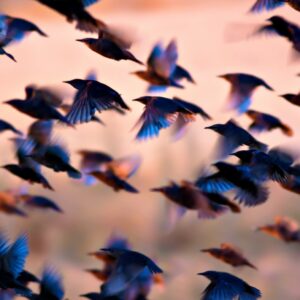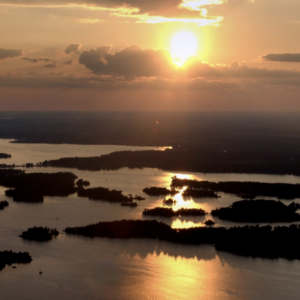
Volunteer guardians Kim and Brendan Toews follow the Endangered Piping Plovers at Sauble Beach through July 7-16.
7 July, 2010
Great public interest in the plovers with many informational brochures taken.
Nest 2 (M1 & F2): Female wasn’t seen today. Male stayed with the two chicks the rest of the day inside the perimeter or shoreline just in front. The chicks and male fed and rested often. One brooding attempt was noted; however, the chick was not successful in getting under the male’s wing. The young are getting their primary wing feathers and were observed flapping their wings today. Guardians are watching for the chicks’ first flight attempts. When they do occur, the plovers could go anywhere on the beach and may also fly south soon after.
Nest 3 (F1 & M5): The birds seemed to have settled and shift changes were seen twice by the guardians.
8 July, 2010
Nest 2 (M1 & F2): One chick seemed to be separated from the male and other chick. The chicks were beating their wings, but no flight attempts were observed.
A single male was chased away by M1 on the ground and in the air.
Nest 3 (F1 & M5): Fox seen in the area. Both plovers continued to incubate. We are still hopeful for a hatch in the next couple of weeks.
9 July, 2010
A special thank you to the Ontario Stewardship Rangers! Six young men and their leader spent all day with us monitoring both nests, conducting a beach survey for other birds and being good ambassadors for the program.
Nest 2 (M1 & F2): The chicks spent most of their day close to the perimeter of Nest 3. Day 18 and short flights were recorded by the guardians. The flights have occurred earlier than last year. Once flights occur we usually consider the birds fledged. The plovers could leave for their wintering grounds (the Gulf Coast) at any time.
Fox were observed on the beach again.
Nest 3 (F1 & M5): Continued action with the single male plover. He was chased by M5 over this area of the beach.
10 July, 2010
Nest 2 (M1 & F2): The male and chicks were foraging closer to the perimeter of Nest 3. Chicks foraged a greater distance from the male. Short flights were seen again today. The two chicks attempted to brood twice but were not successful.
Nest 3 (F1 & M5): Both birds were incubating regularly. Fox seen in the area.
Additional bird: The one single male is being chased by M1 and M5 several times a day.
11 July, 2010 – Merlin Attack!
Nest 2 (M1 & F2): The two chicks and male foraged near Nest 3. When they fed along the shoreline the plovers ventured further south.
Two merlins flew overhead and one dropped down to the plovers. The male flew over the water and drew the merlin away from the chicks who were frozen flat to the sand. Ten to fifteen tense minutes passed, the male returned and both chicks brooded and piped softly under his wings. It is easily possible that a merlin could take an adult. In 2008, we lost our original 2007 Sauble Beach male due to a merlin attack. Fox in the area at the same time as the merlin.
Nest 3 (F1 & M5): Plovers continued to incubate. Guardians did not observe any reaction to the merlin attack.
Additional bird: The single male seems content to remain in this vicinity.
12 July, 2010
Heavy rain for most of the day so monitoring was both limited and difficult.
Nest 2 (M1 & F2): An adult fox was observed on the north end of the beach. Two chicks and the male foraged along the shoreline.
Nest 3 (F1 & M5): Plovers continued to incubate.
13 July, 2010
Nest 2 (M1 & F2): The male and two chicks flew a considerable distance down the beach.
Nest 3 (F1 & M5): Single bird rested inside the perimeter fencing, no aggressive behaviour was observed.
14 July, 2010
Many visitors including a Boy Scout troop from London, ON.
Nest 2 (M1 & F2): One of the chicks was having a bath. Single male feeding in the water by the chicks and was chased by M1 out over the lake. Herring Gull approached the chicks but the male flew in front of it and lured it away. The two chicks flew about 2 m to avoid the gull.
Nest 3 (F1 & M5): Two switch-overs observed about 3 hours apart.
Additional bird: A single male still in the area.
15 July, 2010
Nest 2 (M1 & F2): Chick missing overnight. Guardians are quite certain the plovers flew several hundred metres down the beach so it is possible this chick has left for the south.
The male and one chick seen today foraging near Nest 3. Late afternoon and evening, there was a big storm with high winds. After the big storm, the male and chick moved back inside the northern perimeter.
Nest 3 (F1 & M5): Female was on the scrape most of the day. Water approached the nest and may have covered the eggs. No bird was on the nest for about an hour. Female did return and a digging motion was observed. Perhaps removing washed up sand from the nest area. The female remained on the scrape later into the evening.
16 July, 2010
Nest 2 (M1 & F2): The male and chick were observed just north of the Nest 3 perimeter. The chick found a favourite clump of sand and rested all afternoon and well into the evening. The male visited the chick several times, but the chick did not move from this spot. The chick preened periodically, but no real feeding behaviour was observed.
Nest 3 (F1 & M5): Switch-overs are 90-100 minutes. This is faster than the 2-3 hour switch-overs observed 6 days ago. Times will shorten in preparation for the hatch.
Thanks for the wonderful update, Kim and Brendan. It sounds like the plovers are headed for a successful season.
Catch up on all of this year’s Endangered Piping Plover updates:
Photo by Brendan Toews, btoewsphotos.zenfolio.com




